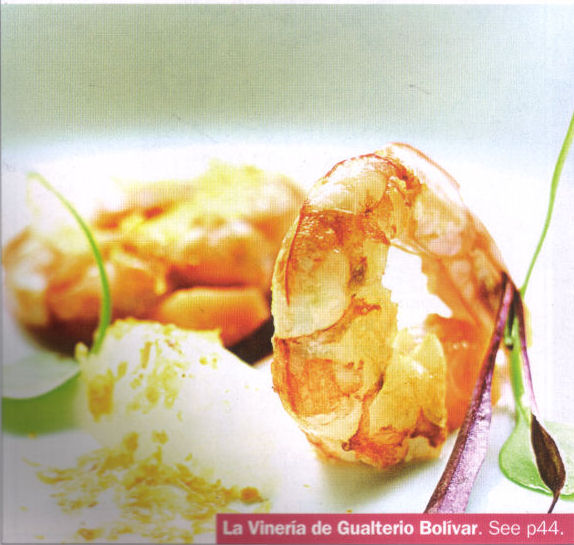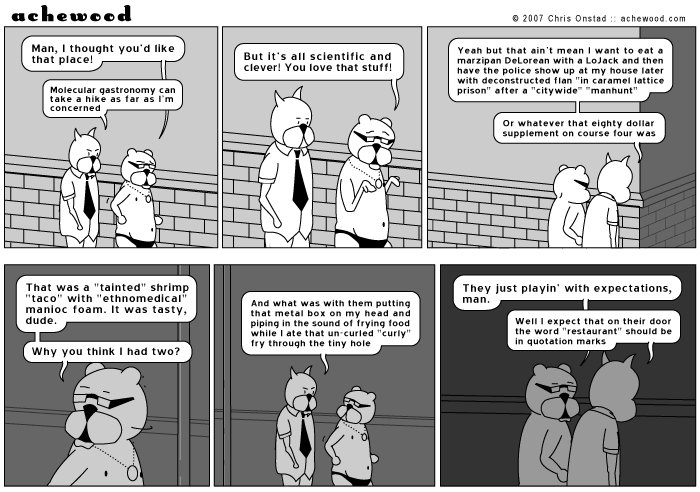Bite-sized bliss
Buenos Aires for Visitors
Summer/Autumn 2009
Page 46
Brush up your skills in the fine art of grazing
Whether you want to call it grazing, small plate food, dim sum, meze, tapas or a chef’s tasting menu, what we’re talking about is gettin gthe chance to sample a lot of small bites of different, interesting food at one sitting. It’s a different way of eating from the traditional three-course dinner, and it tantalizes your palate in a different manner – and makes choosing a dish less of an all-or-nothing situation. It’s also, with the exception of buffet-style eating, fairly new for Buenos Aires.
While many Argentinian restaurants offer what’s called a tabla, it’s often little more than a platter of cold-cuts, cheese and olives. One exception is Breoghan in San Telmo, where you can choose from an array of tablas that offer up exquisite delicacies from Patagonia – fish, game, cheese, vegetables and fruits, in any combination your heart desires – or go for it all with the grand Quimey, a little bite of everything on the menu.
On the tapas side, there’s really only one choice, and thankfully, it’s a good one. Tancat (Paraguay 645, 4312 5442) in the Microcentro offers up a large array of tasty grilled and fried dishes and specializes in seafood and vegetables. While you can grab a table with friends and hang out and order a bit of this and a bit of that, the best thing to do here is to seat yourself at the long bar and start pointing.
When it comes to a chef’s tasting menu, there are three standout places, all of them offering up creatives twists on Argentinian fare and bringing in dishes and flavors from other parts of the world. In the cozy, inviting setting of Thymus you can din on seared duck breast, melt-on-your-tongue lamb’s tongue, or gorgeous roast quail. Or, get yourself into the funky and creative fare at De Olivas i Lustres (Gorriti 3972, Palermo Viejo, 4867 3388), where you’ll find your tastebuds tantalized by plate after plate of little one-bite hors d’oeuvres like ceviche sandwiches, passionfruit alphabet ‘soup’, or the strange sounding but delicious melted cheese with poppyseed caramel. If you really want to put your palate through its paces, you’ll be pleased to know that BA is now home to one of the disciples of Ferran Adrià of Spain’s El Bulli: At La Vinería de Gaulterio Bolivar in San Telmo, you can sample your way through 11 plates of ever-changing, creative cocina de vanguardia, each dish expertly paired with a local wine.
For those who want to step outside traditional or modern Argentinian cuisine, it’s worht nothing that there are two spots that offer up Chinese dim sum (not the classic cart service, but menus that list dozens of options for small plates that you can spread over your table and sample). They are Shi Yuan (Tagle 2531, 4804 0607) in Recoleta, which is also one of the better Chinese restaurants in town, and a few blocks away, Cinco Corderos (Avenida Las Heras 2920, 4806 9466). BA is also home to a very large Armenian community, as well as substantial Syrian and Lebanese ones, and two spots where you can sample lots of such specialties are Sarkis, where you shouldn’t miss the hummus or tabouleh salad, and Cheff Iusef (Malabia 1378, 4773 0450), with its spectacular kebbe de levanie, Both are in Palermo.
In mid-2006, I started writing for Time Out Buenos Aires. With changes in their way of conducting business, I decided to part company with them after my last article and set of reviews in mid-2009.


